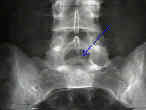- See:
- Vertebral Defects:
- Myelodysplasia:
- Discussion:
- Spina Bifida refers to a local failure of primordia of the two laminae to unite leaves vertebral canal open dorsally (spinal rachischisis, or
spina bifida);
- dorsal body wall may or may not be intact over open vertebral canal;
- sub-types:
- spina bifida occulta:
- defect involves primarily bone, but skin may be attached to Dura, spinal cord, or nerve roots by fibrous bands;
- spina bifida cystica:
- neural tissue may be exposed (myeloschisis)
- meninges may protrude (meningocele)
- spinal cord may protrude (myelomeningocele);
- diastematomyelia:
- related to spina bifida is condition known as diastematomyelia, in which the spinal cord is split by bony spicule or a fibrous band, w/
each portion surrounded by a dural sac;
- as child grows, a long spicule of bone or a fibrous band may tether spinal cord and produce neurologic deficits
Orthopaedic management of high-level spina bifida. Early walking compared with early use of a wheelchair
The high incidence of foot deformity in patients with high-level spina bifida.
Hand function in patients with spina bifida cystica.


